University Public Health Project: Obesity Report and Research
VerifiedAdded on 2023/01/11
|12
|3920
|57
Report
AI Summary
This report delves into the multifaceted issue of obesity, examining its causes in both children and adults, including genetic factors, lifestyle choices, and dietary habits. It explores the detrimental effects of obesity, such as increased risk of diabetes, heart disease, and mental health issues like depression and anxiety, while also addressing methods for controlling obesity from an early age, emphasizing the importance of diet and physical activity. The report utilizes the PICO framework to formulate research questions and discusses both qualitative and quantitative research methods, along with their strengths and weaknesses, to address the research questions. The report also analyzes the strengths and weaknesses of different study designs, ultimately concluding that descriptive research design is the most suitable approach for the study, given the need for detailed information. Secondary sources are used in the form of a literature review to provide evidence-based results and increase the authenticity of the information presented. The report also discusses the complications of obesity and its impact on overall quality of life.
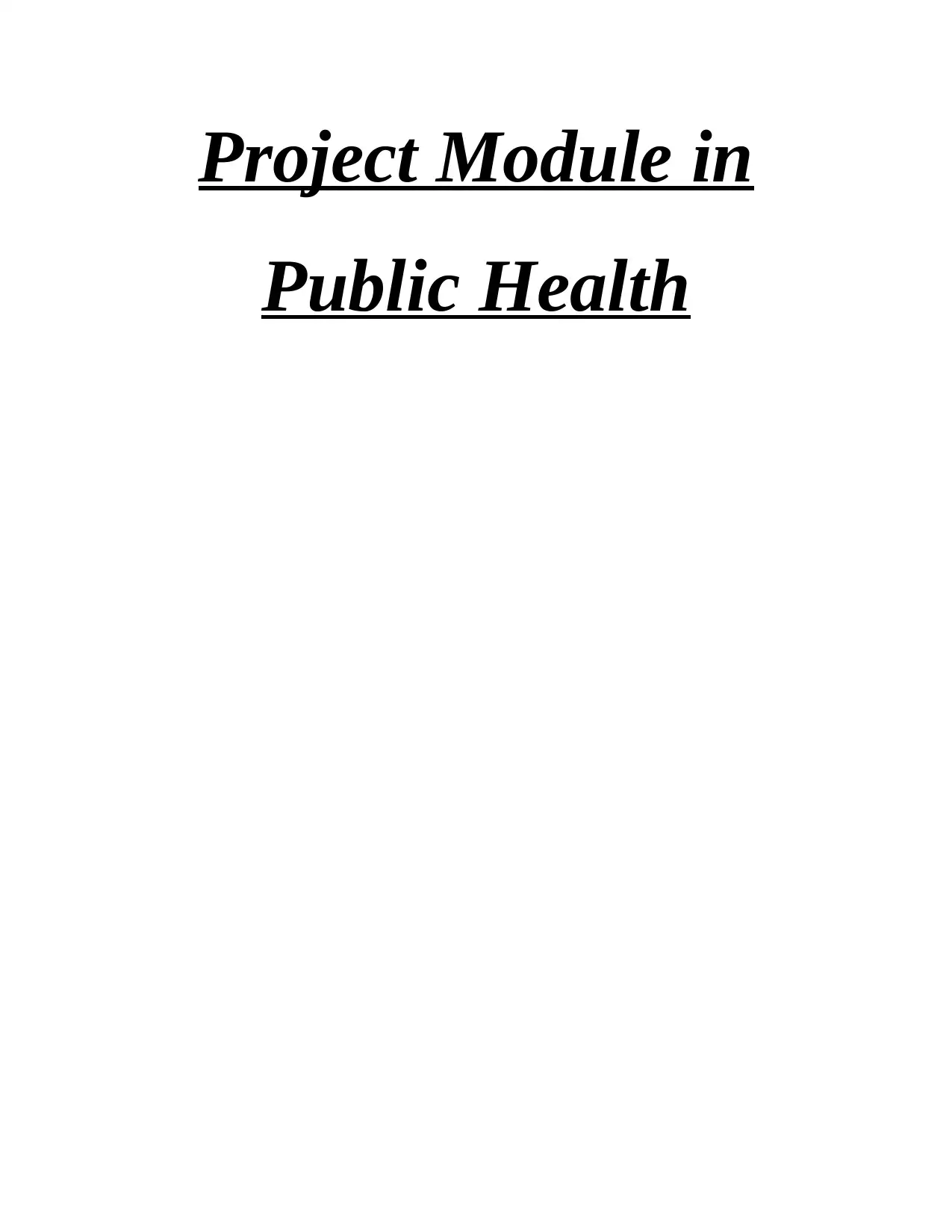
Project Module in
Public Health
Public Health
Paraphrase This Document
Need a fresh take? Get an instant paraphrase of this document with our AI Paraphraser
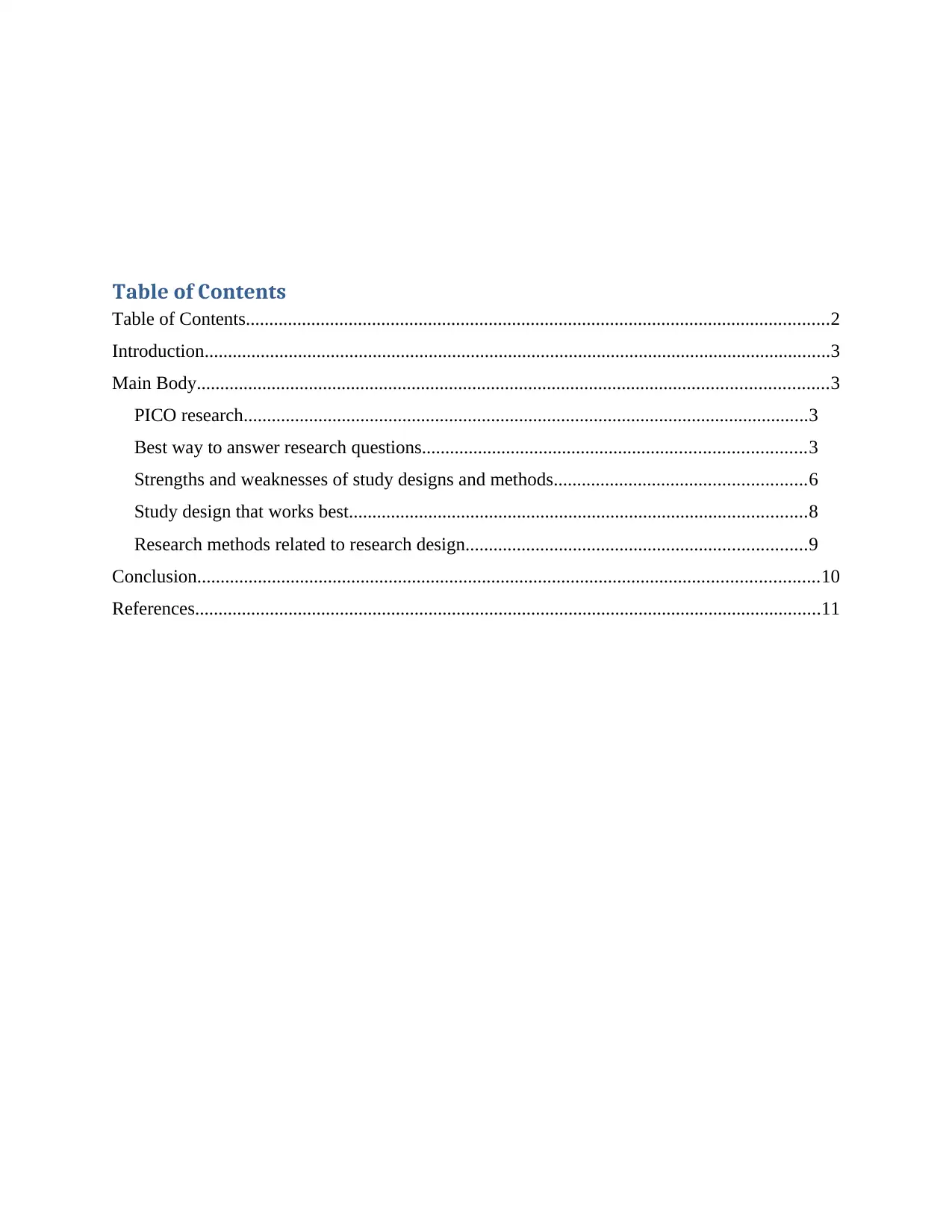
Table of Contents
Table of Contents.............................................................................................................................2
Introduction......................................................................................................................................3
Main Body.......................................................................................................................................3
PICO research.........................................................................................................................3
Best way to answer research questions..................................................................................3
Strengths and weaknesses of study designs and methods......................................................6
Study design that works best..................................................................................................8
Research methods related to research design.........................................................................9
Conclusion.....................................................................................................................................10
References......................................................................................................................................11
Table of Contents.............................................................................................................................2
Introduction......................................................................................................................................3
Main Body.......................................................................................................................................3
PICO research.........................................................................................................................3
Best way to answer research questions..................................................................................3
Strengths and weaknesses of study designs and methods......................................................6
Study design that works best..................................................................................................8
Research methods related to research design.........................................................................9
Conclusion.....................................................................................................................................10
References......................................................................................................................................11
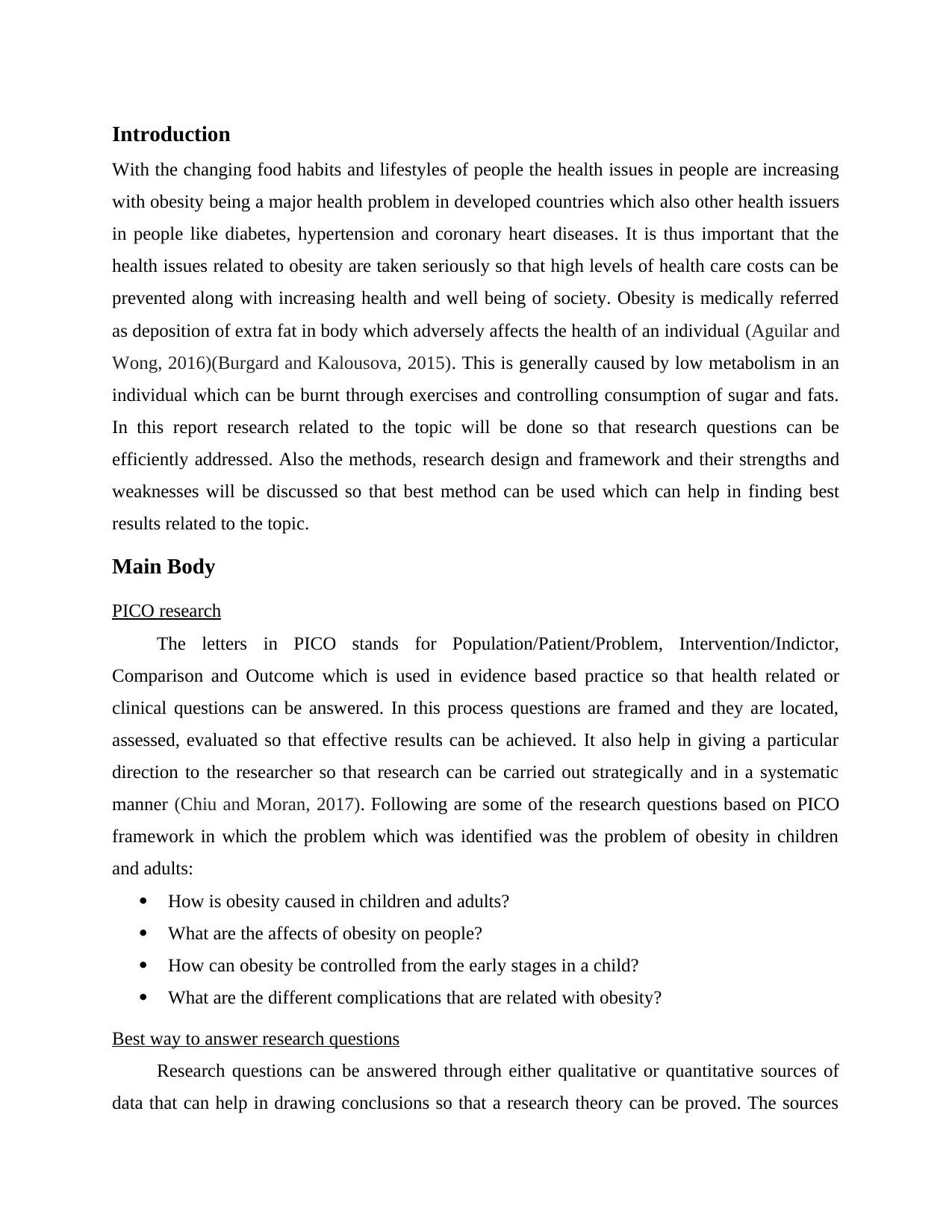
Introduction
With the changing food habits and lifestyles of people the health issues in people are increasing
with obesity being a major health problem in developed countries which also other health issuers
in people like diabetes, hypertension and coronary heart diseases. It is thus important that the
health issues related to obesity are taken seriously so that high levels of health care costs can be
prevented along with increasing health and well being of society. Obesity is medically referred
as deposition of extra fat in body which adversely affects the health of an individual (Aguilar and
Wong, 2016)(Burgard and Kalousova, 2015). This is generally caused by low metabolism in an
individual which can be burnt through exercises and controlling consumption of sugar and fats.
In this report research related to the topic will be done so that research questions can be
efficiently addressed. Also the methods, research design and framework and their strengths and
weaknesses will be discussed so that best method can be used which can help in finding best
results related to the topic.
Main Body
PICO research
The letters in PICO stands for Population/Patient/Problem, Intervention/Indictor,
Comparison and Outcome which is used in evidence based practice so that health related or
clinical questions can be answered. In this process questions are framed and they are located,
assessed, evaluated so that effective results can be achieved. It also help in giving a particular
direction to the researcher so that research can be carried out strategically and in a systematic
manner (Chiu and Moran, 2017). Following are some of the research questions based on PICO
framework in which the problem which was identified was the problem of obesity in children
and adults:
How is obesity caused in children and adults?
What are the affects of obesity on people?
How can obesity be controlled from the early stages in a child?
What are the different complications that are related with obesity?
Best way to answer research questions
Research questions can be answered through either qualitative or quantitative sources of
data that can help in drawing conclusions so that a research theory can be proved. The sources
With the changing food habits and lifestyles of people the health issues in people are increasing
with obesity being a major health problem in developed countries which also other health issuers
in people like diabetes, hypertension and coronary heart diseases. It is thus important that the
health issues related to obesity are taken seriously so that high levels of health care costs can be
prevented along with increasing health and well being of society. Obesity is medically referred
as deposition of extra fat in body which adversely affects the health of an individual (Aguilar and
Wong, 2016)(Burgard and Kalousova, 2015). This is generally caused by low metabolism in an
individual which can be burnt through exercises and controlling consumption of sugar and fats.
In this report research related to the topic will be done so that research questions can be
efficiently addressed. Also the methods, research design and framework and their strengths and
weaknesses will be discussed so that best method can be used which can help in finding best
results related to the topic.
Main Body
PICO research
The letters in PICO stands for Population/Patient/Problem, Intervention/Indictor,
Comparison and Outcome which is used in evidence based practice so that health related or
clinical questions can be answered. In this process questions are framed and they are located,
assessed, evaluated so that effective results can be achieved. It also help in giving a particular
direction to the researcher so that research can be carried out strategically and in a systematic
manner (Chiu and Moran, 2017). Following are some of the research questions based on PICO
framework in which the problem which was identified was the problem of obesity in children
and adults:
How is obesity caused in children and adults?
What are the affects of obesity on people?
How can obesity be controlled from the early stages in a child?
What are the different complications that are related with obesity?
Best way to answer research questions
Research questions can be answered through either qualitative or quantitative sources of
data that can help in drawing conclusions so that a research theory can be proved. The sources
⊘ This is a preview!⊘
Do you want full access?
Subscribe today to unlock all pages.

Trusted by 1+ million students worldwide
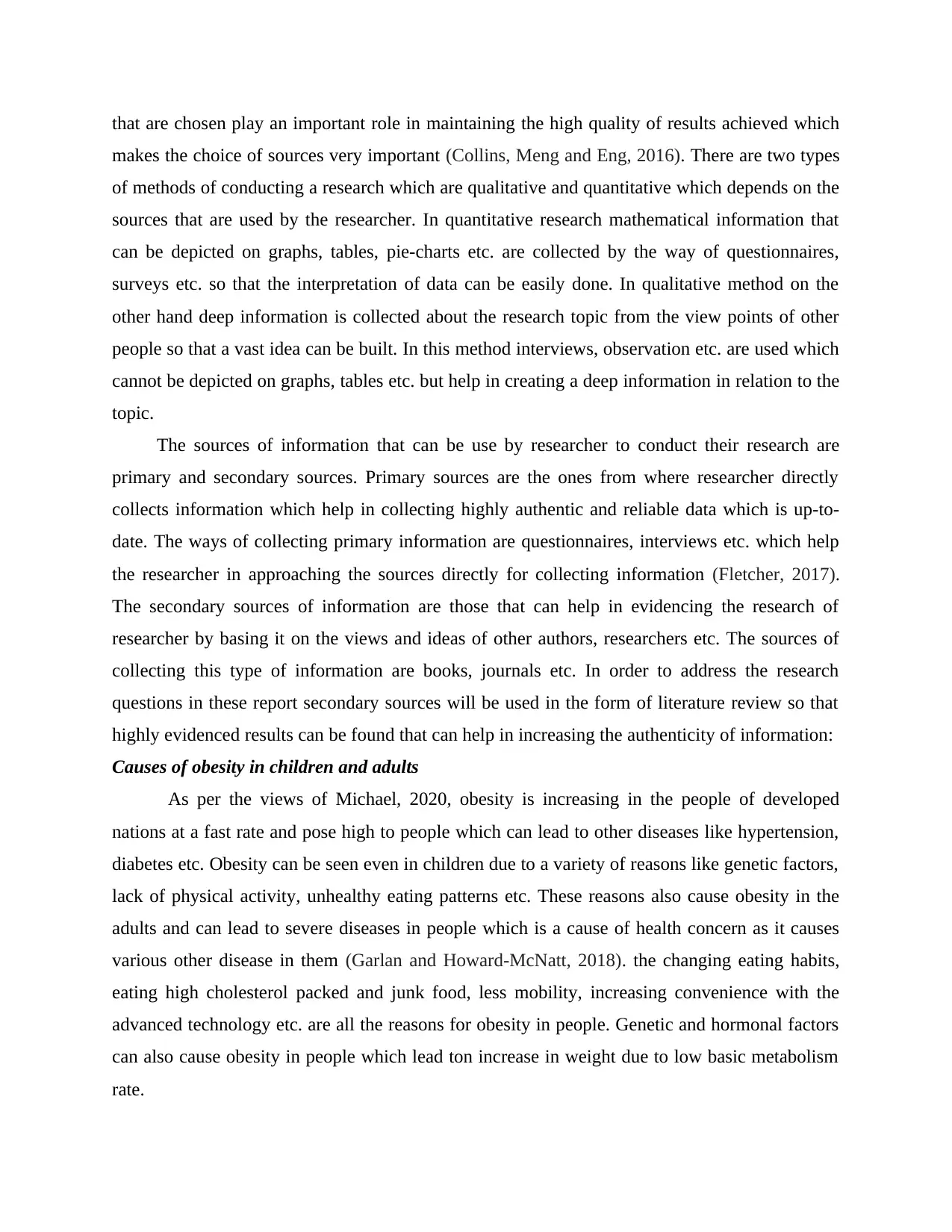
that are chosen play an important role in maintaining the high quality of results achieved which
makes the choice of sources very important (Collins, Meng and Eng, 2016). There are two types
of methods of conducting a research which are qualitative and quantitative which depends on the
sources that are used by the researcher. In quantitative research mathematical information that
can be depicted on graphs, tables, pie-charts etc. are collected by the way of questionnaires,
surveys etc. so that the interpretation of data can be easily done. In qualitative method on the
other hand deep information is collected about the research topic from the view points of other
people so that a vast idea can be built. In this method interviews, observation etc. are used which
cannot be depicted on graphs, tables etc. but help in creating a deep information in relation to the
topic.
The sources of information that can be use by researcher to conduct their research are
primary and secondary sources. Primary sources are the ones from where researcher directly
collects information which help in collecting highly authentic and reliable data which is up-to-
date. The ways of collecting primary information are questionnaires, interviews etc. which help
the researcher in approaching the sources directly for collecting information (Fletcher, 2017).
The secondary sources of information are those that can help in evidencing the research of
researcher by basing it on the views and ideas of other authors, researchers etc. The sources of
collecting this type of information are books, journals etc. In order to address the research
questions in these report secondary sources will be used in the form of literature review so that
highly evidenced results can be found that can help in increasing the authenticity of information:
Causes of obesity in children and adults
As per the views of Michael, 2020, obesity is increasing in the people of developed
nations at a fast rate and pose high to people which can lead to other diseases like hypertension,
diabetes etc. Obesity can be seen even in children due to a variety of reasons like genetic factors,
lack of physical activity, unhealthy eating patterns etc. These reasons also cause obesity in the
adults and can lead to severe diseases in people which is a cause of health concern as it causes
various other disease in them (Garlan and Howard-McNatt, 2018). the changing eating habits,
eating high cholesterol packed and junk food, less mobility, increasing convenience with the
advanced technology etc. are all the reasons for obesity in people. Genetic and hormonal factors
can also cause obesity in people which lead ton increase in weight due to low basic metabolism
rate.
makes the choice of sources very important (Collins, Meng and Eng, 2016). There are two types
of methods of conducting a research which are qualitative and quantitative which depends on the
sources that are used by the researcher. In quantitative research mathematical information that
can be depicted on graphs, tables, pie-charts etc. are collected by the way of questionnaires,
surveys etc. so that the interpretation of data can be easily done. In qualitative method on the
other hand deep information is collected about the research topic from the view points of other
people so that a vast idea can be built. In this method interviews, observation etc. are used which
cannot be depicted on graphs, tables etc. but help in creating a deep information in relation to the
topic.
The sources of information that can be use by researcher to conduct their research are
primary and secondary sources. Primary sources are the ones from where researcher directly
collects information which help in collecting highly authentic and reliable data which is up-to-
date. The ways of collecting primary information are questionnaires, interviews etc. which help
the researcher in approaching the sources directly for collecting information (Fletcher, 2017).
The secondary sources of information are those that can help in evidencing the research of
researcher by basing it on the views and ideas of other authors, researchers etc. The sources of
collecting this type of information are books, journals etc. In order to address the research
questions in these report secondary sources will be used in the form of literature review so that
highly evidenced results can be found that can help in increasing the authenticity of information:
Causes of obesity in children and adults
As per the views of Michael, 2020, obesity is increasing in the people of developed
nations at a fast rate and pose high to people which can lead to other diseases like hypertension,
diabetes etc. Obesity can be seen even in children due to a variety of reasons like genetic factors,
lack of physical activity, unhealthy eating patterns etc. These reasons also cause obesity in the
adults and can lead to severe diseases in people which is a cause of health concern as it causes
various other disease in them (Garlan and Howard-McNatt, 2018). the changing eating habits,
eating high cholesterol packed and junk food, less mobility, increasing convenience with the
advanced technology etc. are all the reasons for obesity in people. Genetic and hormonal factors
can also cause obesity in people which lead ton increase in weight due to low basic metabolism
rate.
Paraphrase This Document
Need a fresh take? Get an instant paraphrase of this document with our AI Paraphraser
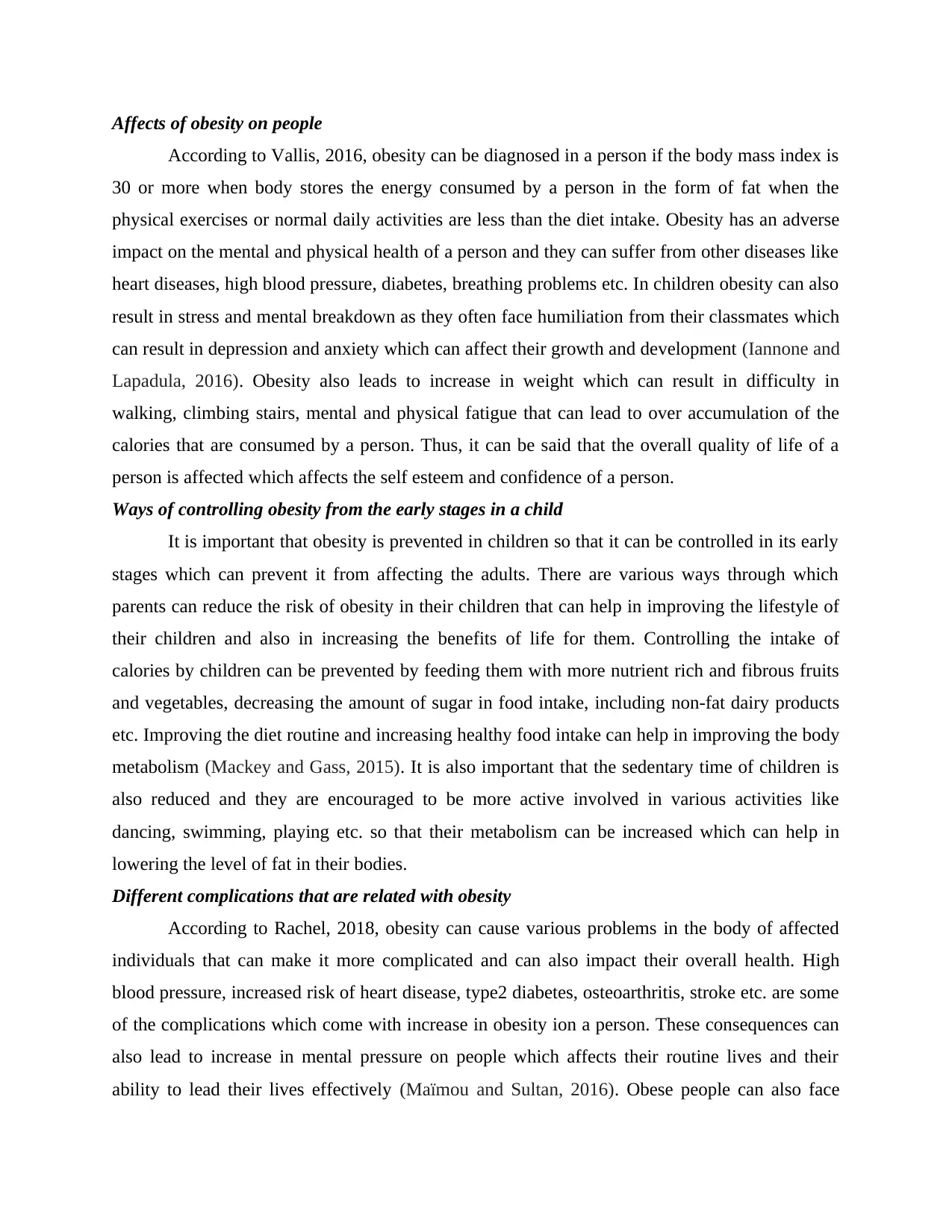
Affects of obesity on people
According to Vallis, 2016, obesity can be diagnosed in a person if the body mass index is
30 or more when body stores the energy consumed by a person in the form of fat when the
physical exercises or normal daily activities are less than the diet intake. Obesity has an adverse
impact on the mental and physical health of a person and they can suffer from other diseases like
heart diseases, high blood pressure, diabetes, breathing problems etc. In children obesity can also
result in stress and mental breakdown as they often face humiliation from their classmates which
can result in depression and anxiety which can affect their growth and development (Iannone and
Lapadula, 2016). Obesity also leads to increase in weight which can result in difficulty in
walking, climbing stairs, mental and physical fatigue that can lead to over accumulation of the
calories that are consumed by a person. Thus, it can be said that the overall quality of life of a
person is affected which affects the self esteem and confidence of a person.
Ways of controlling obesity from the early stages in a child
It is important that obesity is prevented in children so that it can be controlled in its early
stages which can prevent it from affecting the adults. There are various ways through which
parents can reduce the risk of obesity in their children that can help in improving the lifestyle of
their children and also in increasing the benefits of life for them. Controlling the intake of
calories by children can be prevented by feeding them with more nutrient rich and fibrous fruits
and vegetables, decreasing the amount of sugar in food intake, including non-fat dairy products
etc. Improving the diet routine and increasing healthy food intake can help in improving the body
metabolism (Mackey and Gass, 2015). It is also important that the sedentary time of children is
also reduced and they are encouraged to be more active involved in various activities like
dancing, swimming, playing etc. so that their metabolism can be increased which can help in
lowering the level of fat in their bodies.
Different complications that are related with obesity
According to Rachel, 2018, obesity can cause various problems in the body of affected
individuals that can make it more complicated and can also impact their overall health. High
blood pressure, increased risk of heart disease, type2 diabetes, osteoarthritis, stroke etc. are some
of the complications which come with increase in obesity ion a person. These consequences can
also lead to increase in mental pressure on people which affects their routine lives and their
ability to lead their lives effectively (Maïmou and Sultan, 2016). Obese people can also face
According to Vallis, 2016, obesity can be diagnosed in a person if the body mass index is
30 or more when body stores the energy consumed by a person in the form of fat when the
physical exercises or normal daily activities are less than the diet intake. Obesity has an adverse
impact on the mental and physical health of a person and they can suffer from other diseases like
heart diseases, high blood pressure, diabetes, breathing problems etc. In children obesity can also
result in stress and mental breakdown as they often face humiliation from their classmates which
can result in depression and anxiety which can affect their growth and development (Iannone and
Lapadula, 2016). Obesity also leads to increase in weight which can result in difficulty in
walking, climbing stairs, mental and physical fatigue that can lead to over accumulation of the
calories that are consumed by a person. Thus, it can be said that the overall quality of life of a
person is affected which affects the self esteem and confidence of a person.
Ways of controlling obesity from the early stages in a child
It is important that obesity is prevented in children so that it can be controlled in its early
stages which can prevent it from affecting the adults. There are various ways through which
parents can reduce the risk of obesity in their children that can help in improving the lifestyle of
their children and also in increasing the benefits of life for them. Controlling the intake of
calories by children can be prevented by feeding them with more nutrient rich and fibrous fruits
and vegetables, decreasing the amount of sugar in food intake, including non-fat dairy products
etc. Improving the diet routine and increasing healthy food intake can help in improving the body
metabolism (Mackey and Gass, 2015). It is also important that the sedentary time of children is
also reduced and they are encouraged to be more active involved in various activities like
dancing, swimming, playing etc. so that their metabolism can be increased which can help in
lowering the level of fat in their bodies.
Different complications that are related with obesity
According to Rachel, 2018, obesity can cause various problems in the body of affected
individuals that can make it more complicated and can also impact their overall health. High
blood pressure, increased risk of heart disease, type2 diabetes, osteoarthritis, stroke etc. are some
of the complications which come with increase in obesity ion a person. These consequences can
also lead to increase in mental pressure on people which affects their routine lives and their
ability to lead their lives effectively (Maïmou and Sultan, 2016). Obese people can also face
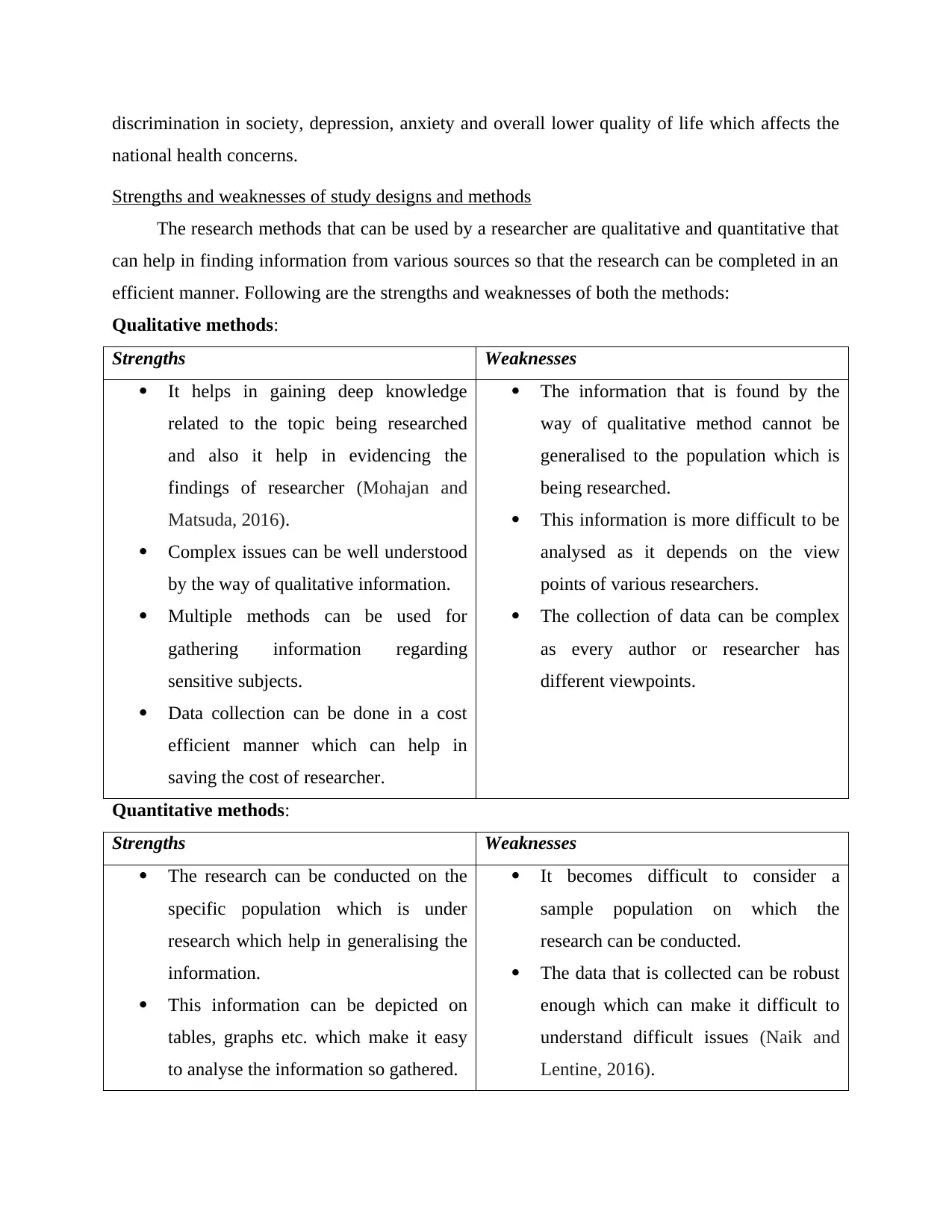
discrimination in society, depression, anxiety and overall lower quality of life which affects the
national health concerns.
Strengths and weaknesses of study designs and methods
The research methods that can be used by a researcher are qualitative and quantitative that
can help in finding information from various sources so that the research can be completed in an
efficient manner. Following are the strengths and weaknesses of both the methods:
Qualitative methods:
Strengths Weaknesses
It helps in gaining deep knowledge
related to the topic being researched
and also it help in evidencing the
findings of researcher (Mohajan and
Matsuda, 2016).
Complex issues can be well understood
by the way of qualitative information.
Multiple methods can be used for
gathering information regarding
sensitive subjects.
Data collection can be done in a cost
efficient manner which can help in
saving the cost of researcher.
The information that is found by the
way of qualitative method cannot be
generalised to the population which is
being researched.
This information is more difficult to be
analysed as it depends on the view
points of various researchers.
The collection of data can be complex
as every author or researcher has
different viewpoints.
Quantitative methods:
Strengths Weaknesses
The research can be conducted on the
specific population which is under
research which help in generalising the
information.
This information can be depicted on
tables, graphs etc. which make it easy
to analyse the information so gathered.
It becomes difficult to consider a
sample population on which the
research can be conducted.
The data that is collected can be robust
enough which can make it difficult to
understand difficult issues (Naik and
Lentine, 2016).
national health concerns.
Strengths and weaknesses of study designs and methods
The research methods that can be used by a researcher are qualitative and quantitative that
can help in finding information from various sources so that the research can be completed in an
efficient manner. Following are the strengths and weaknesses of both the methods:
Qualitative methods:
Strengths Weaknesses
It helps in gaining deep knowledge
related to the topic being researched
and also it help in evidencing the
findings of researcher (Mohajan and
Matsuda, 2016).
Complex issues can be well understood
by the way of qualitative information.
Multiple methods can be used for
gathering information regarding
sensitive subjects.
Data collection can be done in a cost
efficient manner which can help in
saving the cost of researcher.
The information that is found by the
way of qualitative method cannot be
generalised to the population which is
being researched.
This information is more difficult to be
analysed as it depends on the view
points of various researchers.
The collection of data can be complex
as every author or researcher has
different viewpoints.
Quantitative methods:
Strengths Weaknesses
The research can be conducted on the
specific population which is under
research which help in generalising the
information.
This information can be depicted on
tables, graphs etc. which make it easy
to analyse the information so gathered.
It becomes difficult to consider a
sample population on which the
research can be conducted.
The data that is collected can be robust
enough which can make it difficult to
understand difficult issues (Naik and
Lentine, 2016).
⊘ This is a preview!⊘
Do you want full access?
Subscribe today to unlock all pages.

Trusted by 1+ million students worldwide
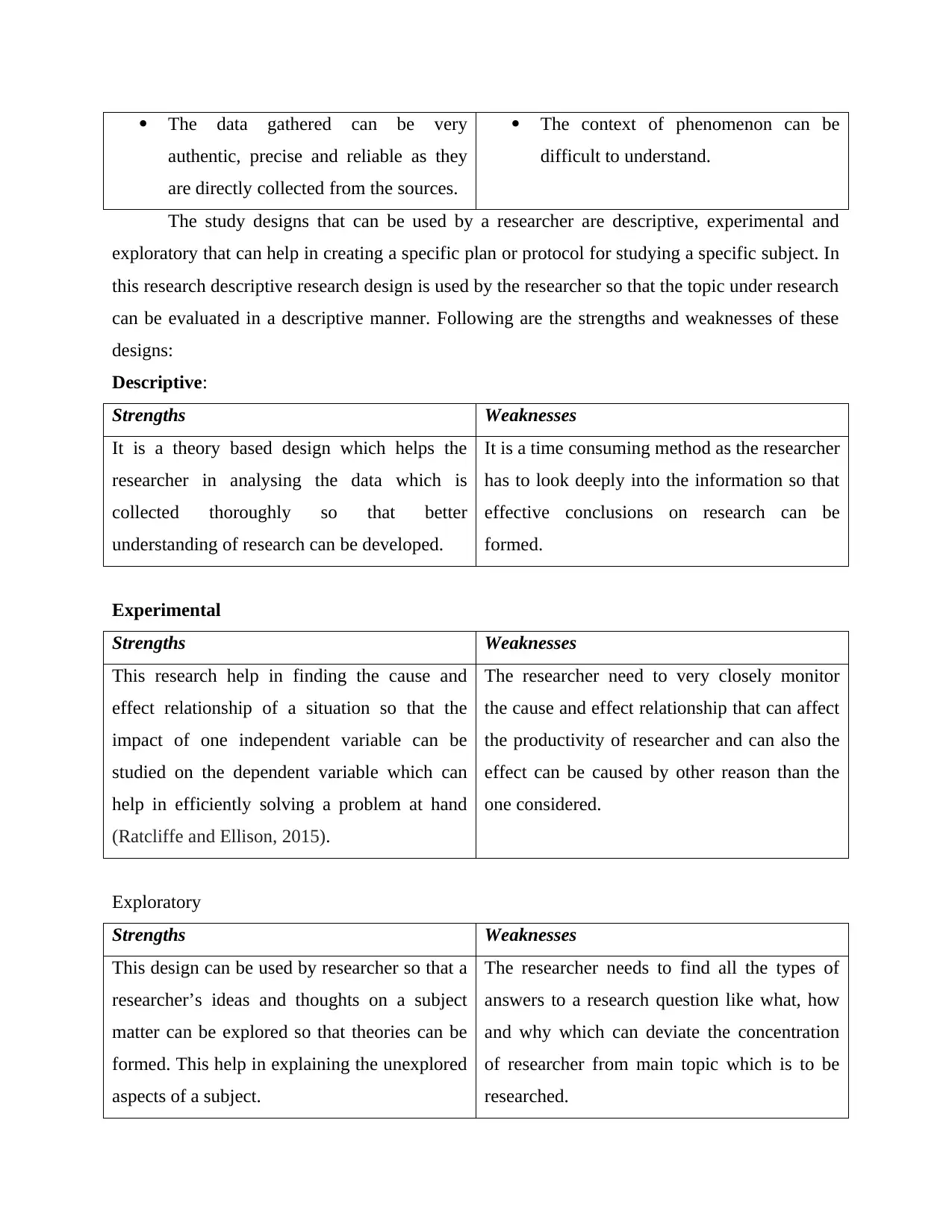
The data gathered can be very
authentic, precise and reliable as they
are directly collected from the sources.
The context of phenomenon can be
difficult to understand.
The study designs that can be used by a researcher are descriptive, experimental and
exploratory that can help in creating a specific plan or protocol for studying a specific subject. In
this research descriptive research design is used by the researcher so that the topic under research
can be evaluated in a descriptive manner. Following are the strengths and weaknesses of these
designs:
Descriptive:
Strengths Weaknesses
It is a theory based design which helps the
researcher in analysing the data which is
collected thoroughly so that better
understanding of research can be developed.
It is a time consuming method as the researcher
has to look deeply into the information so that
effective conclusions on research can be
formed.
Experimental
Strengths Weaknesses
This research help in finding the cause and
effect relationship of a situation so that the
impact of one independent variable can be
studied on the dependent variable which can
help in efficiently solving a problem at hand
(Ratcliffe and Ellison, 2015).
The researcher need to very closely monitor
the cause and effect relationship that can affect
the productivity of researcher and can also the
effect can be caused by other reason than the
one considered.
Exploratory
Strengths Weaknesses
This design can be used by researcher so that a
researcher’s ideas and thoughts on a subject
matter can be explored so that theories can be
formed. This help in explaining the unexplored
aspects of a subject.
The researcher needs to find all the types of
answers to a research question like what, how
and why which can deviate the concentration
of researcher from main topic which is to be
researched.
authentic, precise and reliable as they
are directly collected from the sources.
The context of phenomenon can be
difficult to understand.
The study designs that can be used by a researcher are descriptive, experimental and
exploratory that can help in creating a specific plan or protocol for studying a specific subject. In
this research descriptive research design is used by the researcher so that the topic under research
can be evaluated in a descriptive manner. Following are the strengths and weaknesses of these
designs:
Descriptive:
Strengths Weaknesses
It is a theory based design which helps the
researcher in analysing the data which is
collected thoroughly so that better
understanding of research can be developed.
It is a time consuming method as the researcher
has to look deeply into the information so that
effective conclusions on research can be
formed.
Experimental
Strengths Weaknesses
This research help in finding the cause and
effect relationship of a situation so that the
impact of one independent variable can be
studied on the dependent variable which can
help in efficiently solving a problem at hand
(Ratcliffe and Ellison, 2015).
The researcher need to very closely monitor
the cause and effect relationship that can affect
the productivity of researcher and can also the
effect can be caused by other reason than the
one considered.
Exploratory
Strengths Weaknesses
This design can be used by researcher so that a
researcher’s ideas and thoughts on a subject
matter can be explored so that theories can be
formed. This help in explaining the unexplored
aspects of a subject.
The researcher needs to find all the types of
answers to a research question like what, how
and why which can deviate the concentration
of researcher from main topic which is to be
researched.
Paraphrase This Document
Need a fresh take? Get an instant paraphrase of this document with our AI Paraphraser
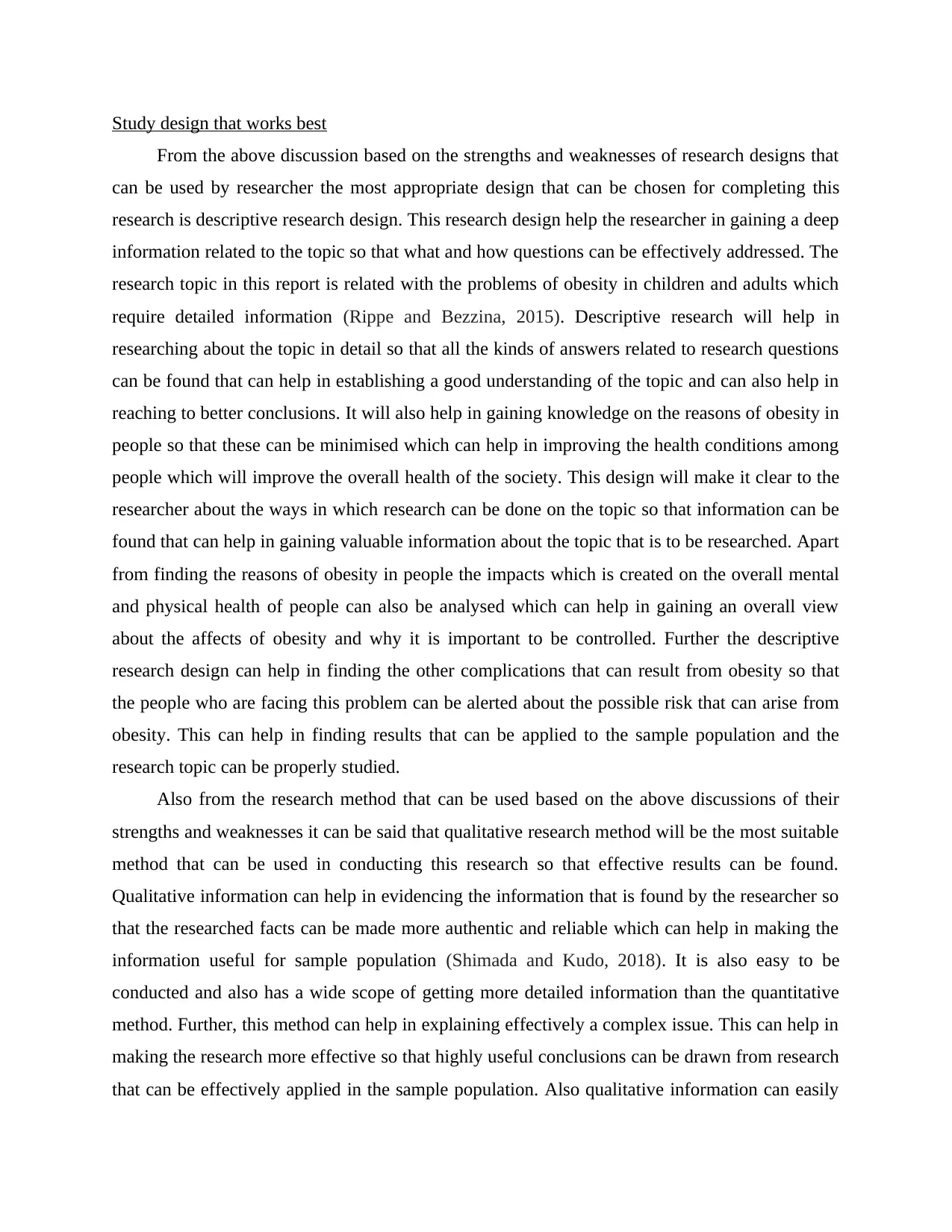
Study design that works best
From the above discussion based on the strengths and weaknesses of research designs that
can be used by researcher the most appropriate design that can be chosen for completing this
research is descriptive research design. This research design help the researcher in gaining a deep
information related to the topic so that what and how questions can be effectively addressed. The
research topic in this report is related with the problems of obesity in children and adults which
require detailed information (Rippe and Bezzina, 2015). Descriptive research will help in
researching about the topic in detail so that all the kinds of answers related to research questions
can be found that can help in establishing a good understanding of the topic and can also help in
reaching to better conclusions. It will also help in gaining knowledge on the reasons of obesity in
people so that these can be minimised which can help in improving the health conditions among
people which will improve the overall health of the society. This design will make it clear to the
researcher about the ways in which research can be done on the topic so that information can be
found that can help in gaining valuable information about the topic that is to be researched. Apart
from finding the reasons of obesity in people the impacts which is created on the overall mental
and physical health of people can also be analysed which can help in gaining an overall view
about the affects of obesity and why it is important to be controlled. Further the descriptive
research design can help in finding the other complications that can result from obesity so that
the people who are facing this problem can be alerted about the possible risk that can arise from
obesity. This can help in finding results that can be applied to the sample population and the
research topic can be properly studied.
Also from the research method that can be used based on the above discussions of their
strengths and weaknesses it can be said that qualitative research method will be the most suitable
method that can be used in conducting this research so that effective results can be found.
Qualitative information can help in evidencing the information that is found by the researcher so
that the researched facts can be made more authentic and reliable which can help in making the
information useful for sample population (Shimada and Kudo, 2018). It is also easy to be
conducted and also has a wide scope of getting more detailed information than the quantitative
method. Further, this method can help in explaining effectively a complex issue. This can help in
making the research more effective so that highly useful conclusions can be drawn from research
that can be effectively applied in the sample population. Also qualitative information can easily
From the above discussion based on the strengths and weaknesses of research designs that
can be used by researcher the most appropriate design that can be chosen for completing this
research is descriptive research design. This research design help the researcher in gaining a deep
information related to the topic so that what and how questions can be effectively addressed. The
research topic in this report is related with the problems of obesity in children and adults which
require detailed information (Rippe and Bezzina, 2015). Descriptive research will help in
researching about the topic in detail so that all the kinds of answers related to research questions
can be found that can help in establishing a good understanding of the topic and can also help in
reaching to better conclusions. It will also help in gaining knowledge on the reasons of obesity in
people so that these can be minimised which can help in improving the health conditions among
people which will improve the overall health of the society. This design will make it clear to the
researcher about the ways in which research can be done on the topic so that information can be
found that can help in gaining valuable information about the topic that is to be researched. Apart
from finding the reasons of obesity in people the impacts which is created on the overall mental
and physical health of people can also be analysed which can help in gaining an overall view
about the affects of obesity and why it is important to be controlled. Further the descriptive
research design can help in finding the other complications that can result from obesity so that
the people who are facing this problem can be alerted about the possible risk that can arise from
obesity. This can help in finding results that can be applied to the sample population and the
research topic can be properly studied.
Also from the research method that can be used based on the above discussions of their
strengths and weaknesses it can be said that qualitative research method will be the most suitable
method that can be used in conducting this research so that effective results can be found.
Qualitative information can help in evidencing the information that is found by the researcher so
that the researched facts can be made more authentic and reliable which can help in making the
information useful for sample population (Shimada and Kudo, 2018). It is also easy to be
conducted and also has a wide scope of getting more detailed information than the quantitative
method. Further, this method can help in explaining effectively a complex issue. This can help in
making the research more effective so that highly useful conclusions can be drawn from research
that can be effectively applied in the sample population. Also qualitative information can easily
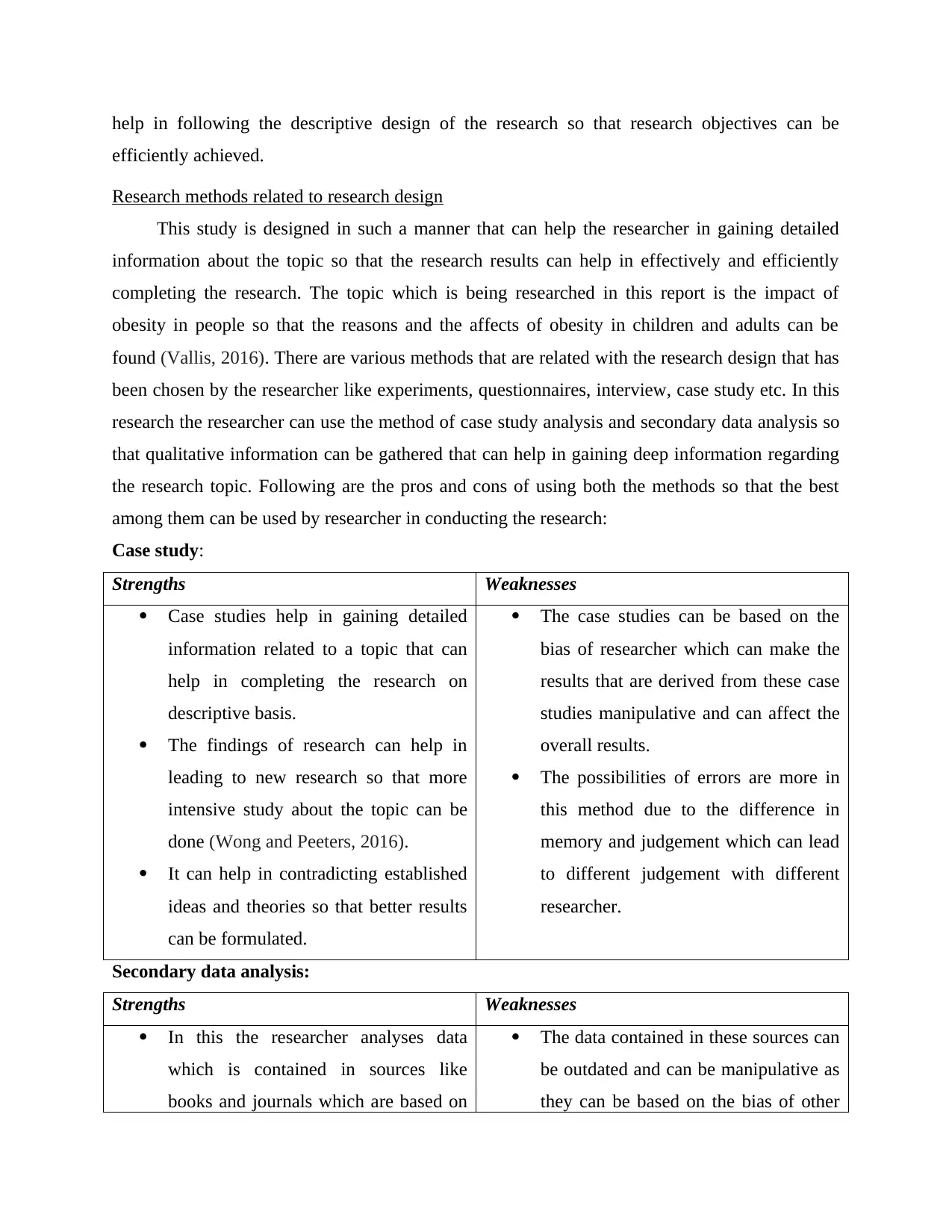
help in following the descriptive design of the research so that research objectives can be
efficiently achieved.
Research methods related to research design
This study is designed in such a manner that can help the researcher in gaining detailed
information about the topic so that the research results can help in effectively and efficiently
completing the research. The topic which is being researched in this report is the impact of
obesity in people so that the reasons and the affects of obesity in children and adults can be
found (Vallis, 2016). There are various methods that are related with the research design that has
been chosen by the researcher like experiments, questionnaires, interview, case study etc. In this
research the researcher can use the method of case study analysis and secondary data analysis so
that qualitative information can be gathered that can help in gaining deep information regarding
the research topic. Following are the pros and cons of using both the methods so that the best
among them can be used by researcher in conducting the research:
Case study:
Strengths Weaknesses
Case studies help in gaining detailed
information related to a topic that can
help in completing the research on
descriptive basis.
The findings of research can help in
leading to new research so that more
intensive study about the topic can be
done (Wong and Peeters, 2016).
It can help in contradicting established
ideas and theories so that better results
can be formulated.
The case studies can be based on the
bias of researcher which can make the
results that are derived from these case
studies manipulative and can affect the
overall results.
The possibilities of errors are more in
this method due to the difference in
memory and judgement which can lead
to different judgement with different
researcher.
Secondary data analysis:
Strengths Weaknesses
In this the researcher analyses data
which is contained in sources like
books and journals which are based on
The data contained in these sources can
be outdated and can be manipulative as
they can be based on the bias of other
efficiently achieved.
Research methods related to research design
This study is designed in such a manner that can help the researcher in gaining detailed
information about the topic so that the research results can help in effectively and efficiently
completing the research. The topic which is being researched in this report is the impact of
obesity in people so that the reasons and the affects of obesity in children and adults can be
found (Vallis, 2016). There are various methods that are related with the research design that has
been chosen by the researcher like experiments, questionnaires, interview, case study etc. In this
research the researcher can use the method of case study analysis and secondary data analysis so
that qualitative information can be gathered that can help in gaining deep information regarding
the research topic. Following are the pros and cons of using both the methods so that the best
among them can be used by researcher in conducting the research:
Case study:
Strengths Weaknesses
Case studies help in gaining detailed
information related to a topic that can
help in completing the research on
descriptive basis.
The findings of research can help in
leading to new research so that more
intensive study about the topic can be
done (Wong and Peeters, 2016).
It can help in contradicting established
ideas and theories so that better results
can be formulated.
The case studies can be based on the
bias of researcher which can make the
results that are derived from these case
studies manipulative and can affect the
overall results.
The possibilities of errors are more in
this method due to the difference in
memory and judgement which can lead
to different judgement with different
researcher.
Secondary data analysis:
Strengths Weaknesses
In this the researcher analyses data
which is contained in sources like
books and journals which are based on
The data contained in these sources can
be outdated and can be manipulative as
they can be based on the bias of other
⊘ This is a preview!⊘
Do you want full access?
Subscribe today to unlock all pages.

Trusted by 1+ million students worldwide
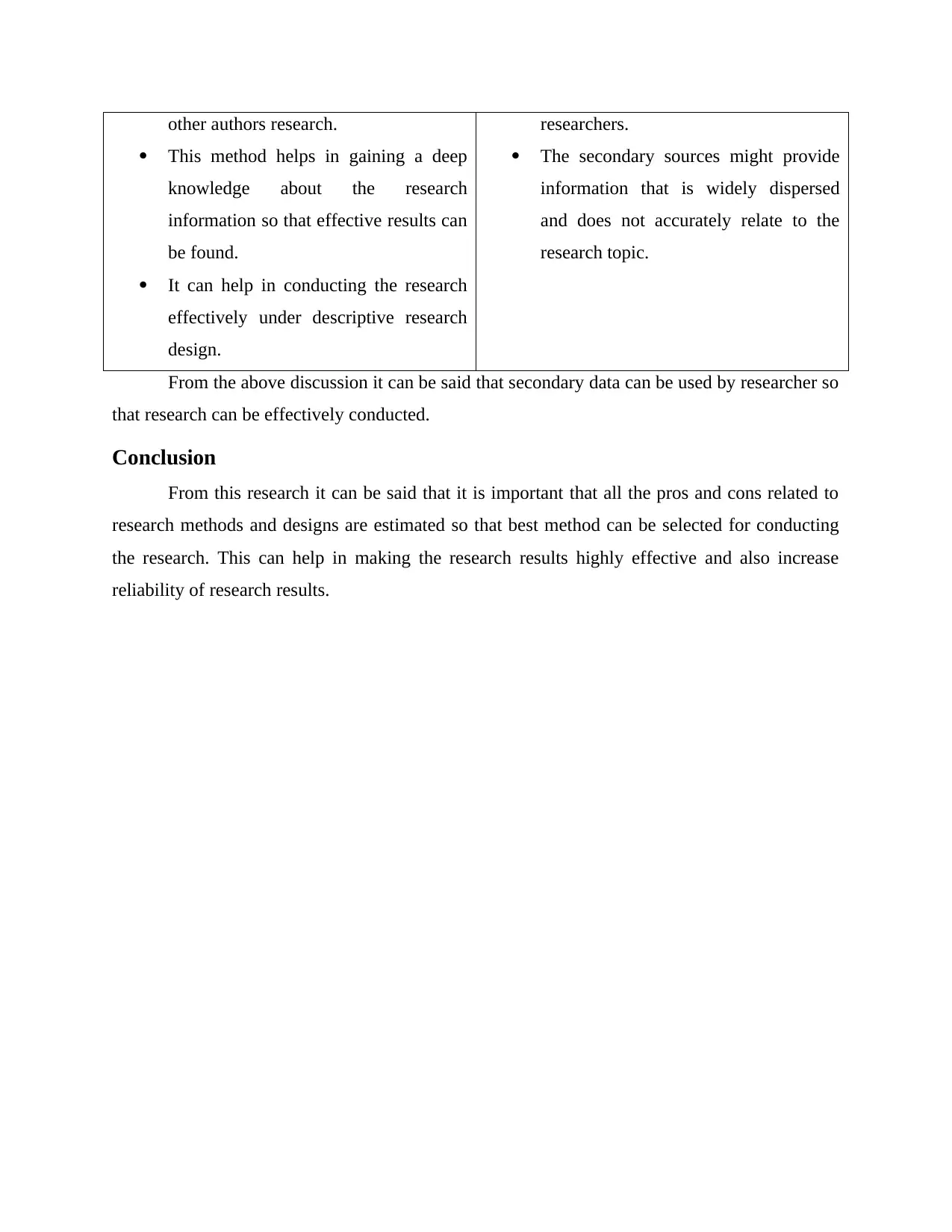
other authors research.
This method helps in gaining a deep
knowledge about the research
information so that effective results can
be found.
It can help in conducting the research
effectively under descriptive research
design.
researchers.
The secondary sources might provide
information that is widely dispersed
and does not accurately relate to the
research topic.
From the above discussion it can be said that secondary data can be used by researcher so
that research can be effectively conducted.
Conclusion
From this research it can be said that it is important that all the pros and cons related to
research methods and designs are estimated so that best method can be selected for conducting
the research. This can help in making the research results highly effective and also increase
reliability of research results.
This method helps in gaining a deep
knowledge about the research
information so that effective results can
be found.
It can help in conducting the research
effectively under descriptive research
design.
researchers.
The secondary sources might provide
information that is widely dispersed
and does not accurately relate to the
research topic.
From the above discussion it can be said that secondary data can be used by researcher so
that research can be effectively conducted.
Conclusion
From this research it can be said that it is important that all the pros and cons related to
research methods and designs are estimated so that best method can be selected for conducting
the research. This can help in making the research results highly effective and also increase
reliability of research results.
Paraphrase This Document
Need a fresh take? Get an instant paraphrase of this document with our AI Paraphraser
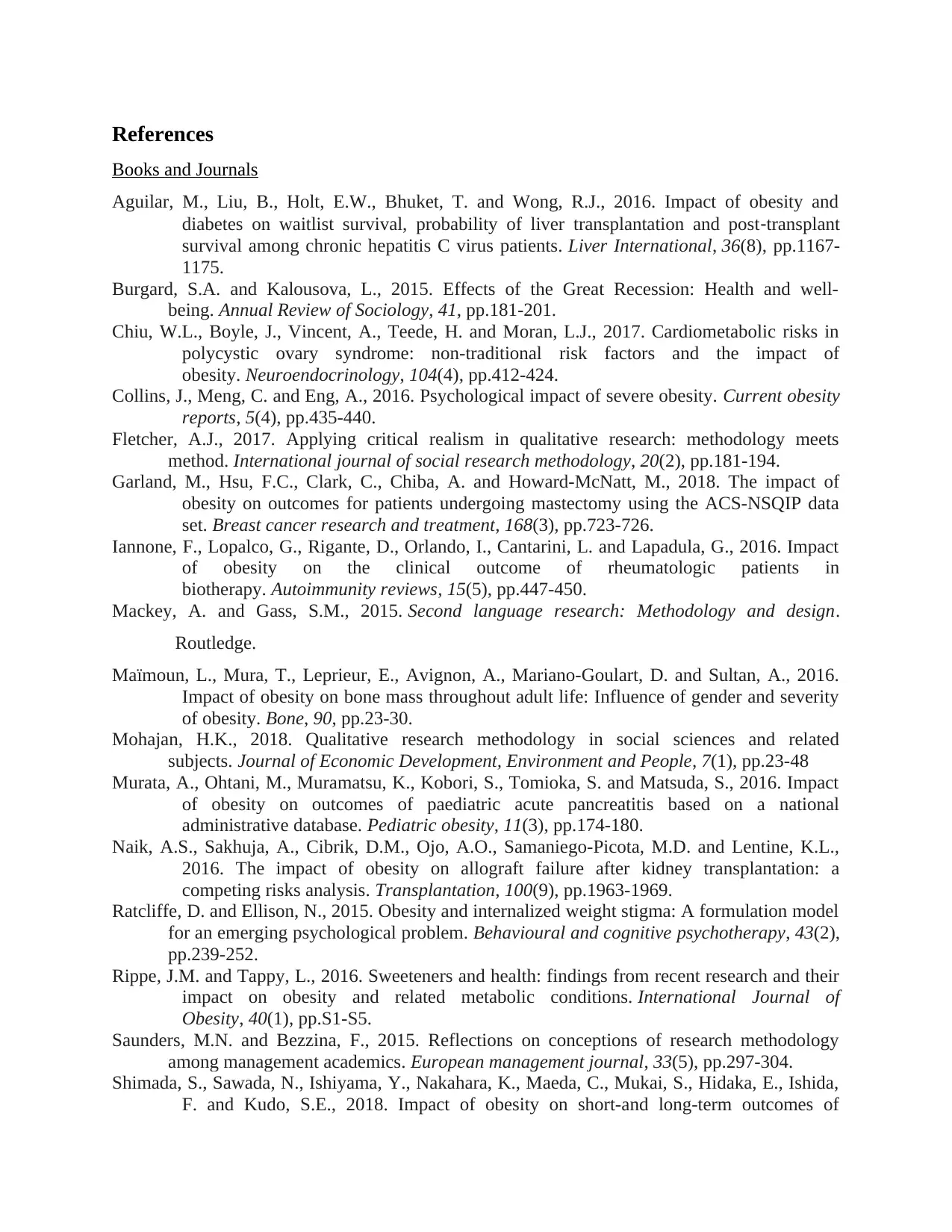
References
Books and Journals
Aguilar, M., Liu, B., Holt, E.W., Bhuket, T. and Wong, R.J., 2016. Impact of obesity and
diabetes on waitlist survival, probability of liver transplantation and post‐transplant
survival among chronic hepatitis C virus patients. Liver International, 36(8), pp.1167-
1175.
Burgard, S.A. and Kalousova, L., 2015. Effects of the Great Recession: Health and well-
being. Annual Review of Sociology, 41, pp.181-201.
Chiu, W.L., Boyle, J., Vincent, A., Teede, H. and Moran, L.J., 2017. Cardiometabolic risks in
polycystic ovary syndrome: non-traditional risk factors and the impact of
obesity. Neuroendocrinology, 104(4), pp.412-424.
Collins, J., Meng, C. and Eng, A., 2016. Psychological impact of severe obesity. Current obesity
reports, 5(4), pp.435-440.
Fletcher, A.J., 2017. Applying critical realism in qualitative research: methodology meets
method. International journal of social research methodology, 20(2), pp.181-194.
Garland, M., Hsu, F.C., Clark, C., Chiba, A. and Howard-McNatt, M., 2018. The impact of
obesity on outcomes for patients undergoing mastectomy using the ACS-NSQIP data
set. Breast cancer research and treatment, 168(3), pp.723-726.
Iannone, F., Lopalco, G., Rigante, D., Orlando, I., Cantarini, L. and Lapadula, G., 2016. Impact
of obesity on the clinical outcome of rheumatologic patients in
biotherapy. Autoimmunity reviews, 15(5), pp.447-450.
Mackey, A. and Gass, S.M., 2015. Second language research: Methodology and design.
Routledge.
Maïmoun, L., Mura, T., Leprieur, E., Avignon, A., Mariano-Goulart, D. and Sultan, A., 2016.
Impact of obesity on bone mass throughout adult life: Influence of gender and severity
of obesity. Bone, 90, pp.23-30.
Mohajan, H.K., 2018. Qualitative research methodology in social sciences and related
subjects. Journal of Economic Development, Environment and People, 7(1), pp.23-48
Murata, A., Ohtani, M., Muramatsu, K., Kobori, S., Tomioka, S. and Matsuda, S., 2016. Impact
of obesity on outcomes of paediatric acute pancreatitis based on a national
administrative database. Pediatric obesity, 11(3), pp.174-180.
Naik, A.S., Sakhuja, A., Cibrik, D.M., Ojo, A.O., Samaniego-Picota, M.D. and Lentine, K.L.,
2016. The impact of obesity on allograft failure after kidney transplantation: a
competing risks analysis. Transplantation, 100(9), pp.1963-1969.
Ratcliffe, D. and Ellison, N., 2015. Obesity and internalized weight stigma: A formulation model
for an emerging psychological problem. Behavioural and cognitive psychotherapy, 43(2),
pp.239-252.
Rippe, J.M. and Tappy, L., 2016. Sweeteners and health: findings from recent research and their
impact on obesity and related metabolic conditions. International Journal of
Obesity, 40(1), pp.S1-S5.
Saunders, M.N. and Bezzina, F., 2015. Reflections on conceptions of research methodology
among management academics. European management journal, 33(5), pp.297-304.
Shimada, S., Sawada, N., Ishiyama, Y., Nakahara, K., Maeda, C., Mukai, S., Hidaka, E., Ishida,
F. and Kudo, S.E., 2018. Impact of obesity on short-and long-term outcomes of
Books and Journals
Aguilar, M., Liu, B., Holt, E.W., Bhuket, T. and Wong, R.J., 2016. Impact of obesity and
diabetes on waitlist survival, probability of liver transplantation and post‐transplant
survival among chronic hepatitis C virus patients. Liver International, 36(8), pp.1167-
1175.
Burgard, S.A. and Kalousova, L., 2015. Effects of the Great Recession: Health and well-
being. Annual Review of Sociology, 41, pp.181-201.
Chiu, W.L., Boyle, J., Vincent, A., Teede, H. and Moran, L.J., 2017. Cardiometabolic risks in
polycystic ovary syndrome: non-traditional risk factors and the impact of
obesity. Neuroendocrinology, 104(4), pp.412-424.
Collins, J., Meng, C. and Eng, A., 2016. Psychological impact of severe obesity. Current obesity
reports, 5(4), pp.435-440.
Fletcher, A.J., 2017. Applying critical realism in qualitative research: methodology meets
method. International journal of social research methodology, 20(2), pp.181-194.
Garland, M., Hsu, F.C., Clark, C., Chiba, A. and Howard-McNatt, M., 2018. The impact of
obesity on outcomes for patients undergoing mastectomy using the ACS-NSQIP data
set. Breast cancer research and treatment, 168(3), pp.723-726.
Iannone, F., Lopalco, G., Rigante, D., Orlando, I., Cantarini, L. and Lapadula, G., 2016. Impact
of obesity on the clinical outcome of rheumatologic patients in
biotherapy. Autoimmunity reviews, 15(5), pp.447-450.
Mackey, A. and Gass, S.M., 2015. Second language research: Methodology and design.
Routledge.
Maïmoun, L., Mura, T., Leprieur, E., Avignon, A., Mariano-Goulart, D. and Sultan, A., 2016.
Impact of obesity on bone mass throughout adult life: Influence of gender and severity
of obesity. Bone, 90, pp.23-30.
Mohajan, H.K., 2018. Qualitative research methodology in social sciences and related
subjects. Journal of Economic Development, Environment and People, 7(1), pp.23-48
Murata, A., Ohtani, M., Muramatsu, K., Kobori, S., Tomioka, S. and Matsuda, S., 2016. Impact
of obesity on outcomes of paediatric acute pancreatitis based on a national
administrative database. Pediatric obesity, 11(3), pp.174-180.
Naik, A.S., Sakhuja, A., Cibrik, D.M., Ojo, A.O., Samaniego-Picota, M.D. and Lentine, K.L.,
2016. The impact of obesity on allograft failure after kidney transplantation: a
competing risks analysis. Transplantation, 100(9), pp.1963-1969.
Ratcliffe, D. and Ellison, N., 2015. Obesity and internalized weight stigma: A formulation model
for an emerging psychological problem. Behavioural and cognitive psychotherapy, 43(2),
pp.239-252.
Rippe, J.M. and Tappy, L., 2016. Sweeteners and health: findings from recent research and their
impact on obesity and related metabolic conditions. International Journal of
Obesity, 40(1), pp.S1-S5.
Saunders, M.N. and Bezzina, F., 2015. Reflections on conceptions of research methodology
among management academics. European management journal, 33(5), pp.297-304.
Shimada, S., Sawada, N., Ishiyama, Y., Nakahara, K., Maeda, C., Mukai, S., Hidaka, E., Ishida,
F. and Kudo, S.E., 2018. Impact of obesity on short-and long-term outcomes of
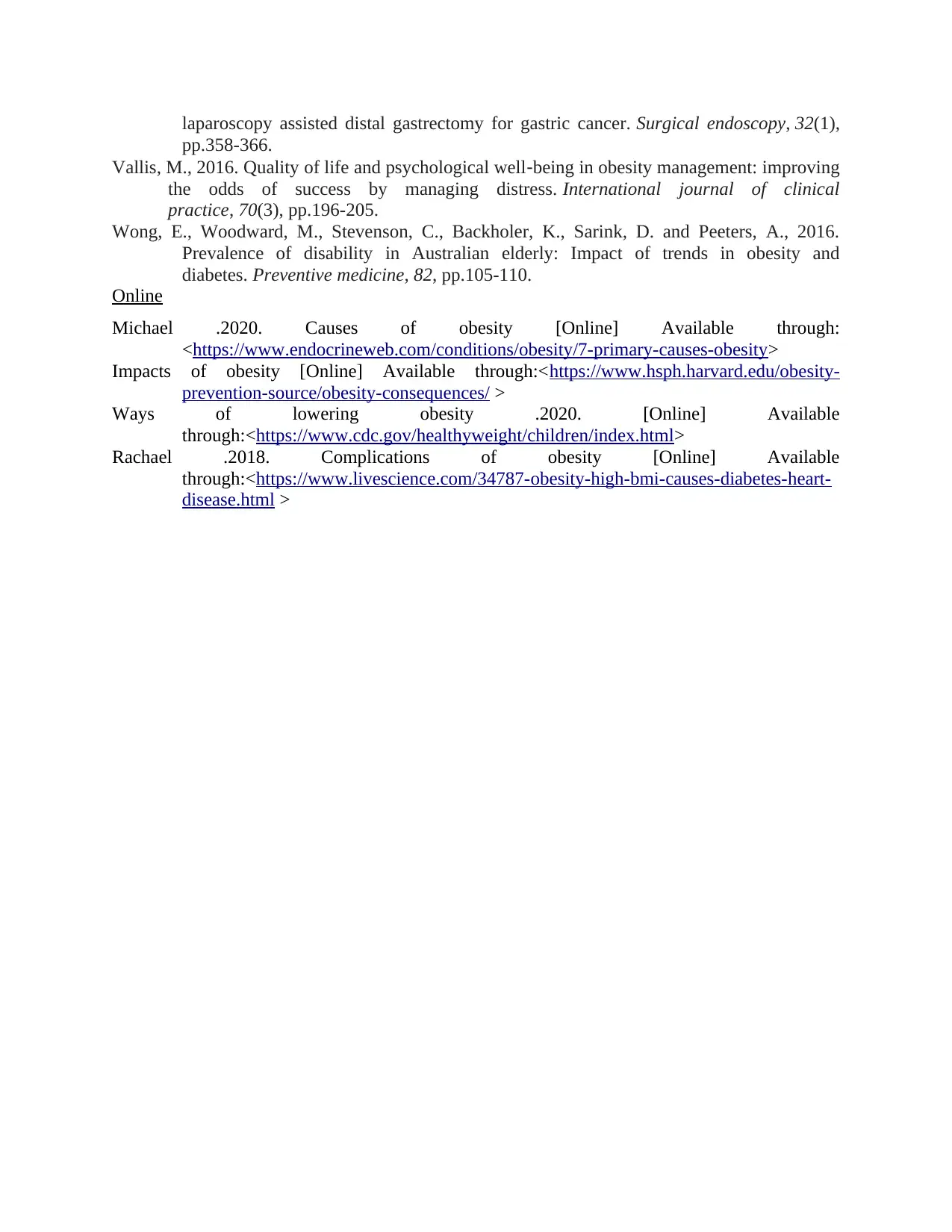
laparoscopy assisted distal gastrectomy for gastric cancer. Surgical endoscopy, 32(1),
pp.358-366.
Vallis, M., 2016. Quality of life and psychological well‐being in obesity management: improving
the odds of success by managing distress. International journal of clinical
practice, 70(3), pp.196-205.
Wong, E., Woodward, M., Stevenson, C., Backholer, K., Sarink, D. and Peeters, A., 2016.
Prevalence of disability in Australian elderly: Impact of trends in obesity and
diabetes. Preventive medicine, 82, pp.105-110.
Online
Michael .2020. Causes of obesity [Online] Available through:
<https://www.endocrineweb.com/conditions/obesity/7-primary-causes-obesity>
Impacts of obesity [Online] Available through:<https://www.hsph.harvard.edu/obesity-
prevention-source/obesity-consequences/ >
Ways of lowering obesity .2020. [Online] Available
through:<https://www.cdc.gov/healthyweight/children/index.html>
Rachael .2018. Complications of obesity [Online] Available
through:<https://www.livescience.com/34787-obesity-high-bmi-causes-diabetes-heart-
disease.html >
pp.358-366.
Vallis, M., 2016. Quality of life and psychological well‐being in obesity management: improving
the odds of success by managing distress. International journal of clinical
practice, 70(3), pp.196-205.
Wong, E., Woodward, M., Stevenson, C., Backholer, K., Sarink, D. and Peeters, A., 2016.
Prevalence of disability in Australian elderly: Impact of trends in obesity and
diabetes. Preventive medicine, 82, pp.105-110.
Online
Michael .2020. Causes of obesity [Online] Available through:
<https://www.endocrineweb.com/conditions/obesity/7-primary-causes-obesity>
Impacts of obesity [Online] Available through:<https://www.hsph.harvard.edu/obesity-
prevention-source/obesity-consequences/ >
Ways of lowering obesity .2020. [Online] Available
through:<https://www.cdc.gov/healthyweight/children/index.html>
Rachael .2018. Complications of obesity [Online] Available
through:<https://www.livescience.com/34787-obesity-high-bmi-causes-diabetes-heart-
disease.html >
⊘ This is a preview!⊘
Do you want full access?
Subscribe today to unlock all pages.

Trusted by 1+ million students worldwide
1 out of 12
Related Documents
Your All-in-One AI-Powered Toolkit for Academic Success.
+13062052269
info@desklib.com
Available 24*7 on WhatsApp / Email
![[object Object]](/_next/static/media/star-bottom.7253800d.svg)
Unlock your academic potential
Copyright © 2020–2025 A2Z Services. All Rights Reserved. Developed and managed by ZUCOL.





